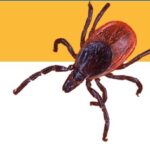 With tick season upon us, the Eastern Ontario Health Unit (EOHU) is cautioning residents that populations of blacklegged ticks, which can spread Lyme disease to humans, are growing in locations across the five eastern counties. The EOHU region has known risk areas where blacklegged ticks have been identified and where individuals have the potential to come into contact with infected ticks. Visit www.eohu.ca/lyme to view Ontario’s risk area map.
With tick season upon us, the Eastern Ontario Health Unit (EOHU) is cautioning residents that populations of blacklegged ticks, which can spread Lyme disease to humans, are growing in locations across the five eastern counties. The EOHU region has known risk areas where blacklegged ticks have been identified and where individuals have the potential to come into contact with infected ticks. Visit www.eohu.ca/lyme to view Ontario’s risk area map.
Lyme disease is a serious illness that can cause the following symptoms, usually within 3 to 30 days after a tick bite:
- Fever
- Headache
- Muscle aches and joint pains
- Stiff neck
- Decreased appetite
- Fatigue
- Swollen glands
- Rash (although many people never get or see a rash)
The risk of Lyme disease transmission from a tick to a human is very low if the tick is attached for less than 24 hours, however, that risk climbs if an infected tick is attached for over 24 hours. “It’s important to contact your healthcare provider if you believe a tick was attached for more than 24 hours or if you develop flu-like symptoms or an expanding rash in the weeks following a tick bite” says Dr. Paul Roumeliotis, Medical Officer of Health at the EOHU. “If Lyme infection isn’t recognized and treated, symptoms can last from months to years and include serious health problems affecting the heart, nervous system or joints.” Most cases of Lyme disease can be treated successfully with antibiotics.
Ticks are most active in the spring and summer months but can be found at any time of the year when the temperature is above freezing, usually in woodlands, tall grasses and bushes. There are measures you can take to discourage the presence of ticks around your home and to keep ticks off you, your family and your pets.
For more information on how to protect yourself and your loved ones from ticks and Lyme disease, visit www.eohu.ca/lyme.

